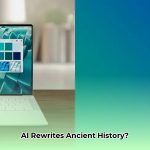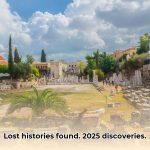Imagine having an incredibly knowledgeable assistant capable of deciphering the riddles of ancient Egypt, Rome, or Greece. That’s precisely the role AI is starting to play in ancient history. It’s not about replacing historians, but rather providing a powerful analytical lens that highlights patterns and details that might otherwise be overlooked. This article delves into the fascinating world of AI tools currently aiding our comprehension of the past. We’ll examine their functionalities, limitations, and the ethical considerations they present. Prepare for a journey into history, empowered by cutting-edge technology! For further reading, check out these ancient history books.
Revolutionizing Our Understanding: The Best Ancient History AI Systems
Envision piecing together a massive jigsaw puzzle with only a handful of scattered fragments, many broken and inscribed in an unfamiliar script. This is the challenge historians face when studying ancient civilizations. Now, picture having an intelligent assistant that could locate missing pieces, interpret the inscriptions, and propose how they fit together. That’s the transformative potential of artificial intelligence (AI) in ancient history. The most effective AI systems don’t supplant historians; instead, they serve as powerful instruments that enhance their capabilities, opening doors to groundbreaking discoveries in historical analysis.
Deciphering Ancient Complexities: AI – A New Lens on the Past
These AI systems are performing remarkable feats. Consider the daunting task of deciphering ancient languages such as hieroglyphs or cuneiform— a endeavor requiring years of dedicated study. Now, imagine AI software rapidly interpreting these ancient scripts, potentially unveiling entirely new historical narratives. This is not mere speculation. Natural Language Processing (NLP), a branch of AI that enables computers to comprehend and manipulate human language, is already facilitating significant progress in this domain. Similarly, computer vision techniques are generating stunning 3D models of ancient sites from fragmented ruins and artifacts. These models allow us to virtually explore lost cities and admire long-gone monuments, thus enhancing our understanding of their original appearance. AI is also mapping ancient settlements and trade routes with unprecedented precision through sophisticated geospatial analysis (the analysis of data linked to specific locations). This capability is like uncovering an entirely new layer of detail superimposed on existing maps. How will AI-driven discoveries reshape our perspective on the interactions and daily lives within ancient civilizations?
- Enhanced Decipherment: Rapidly interprets ancient scripts, potentially revealing new historical narratives.
- Virtual Exploration: Generates breathtaking 3D models of ancient sites, enabling virtual exploration.
- Accurate Mapping: Maps ancient settlements and trade routes with unmatched precision through geospatial analysis.
Navigating Challenges: The Potential and the Pitfalls in Ancient History AI
While the possibilities appear boundless, we must acknowledge certain limitations. AI excels at identifying patterns, but interpreting the significance of those patterns requires human insight. A seasoned historian brings cultural understanding, subtle nuances, and a wealth of contextual knowledge that even the most advanced AI currently lacks. This human element is indispensable, considering that even sophisticated AI is constrained by its training data. If the information used to train the AI contains biases, its conclusions may mirror those biases. This poses a significant concern when dealing with ancient cultures and the susceptibility to misinterpretations. Therefore, careful attention is required in the development and application of these tools. For instance, if an AI is primarily trained on texts extolling rulers, it may fail to accurately represent the lives of ordinary citizens.
Another concern is ethical. Who has ownership of the data used to train these AI systems? Who determines how the AI’s findings should be interpreted? These questions extend beyond the technical domain and encompass issues of cultural sensitivity and the very ownership of history. Thoughtful dialogue is essential to establish responsible guidelines for utilizing AI in this field.
The Future is Collaborative: Synergizing AI and Human Expertise
Despite the challenges, the future of AI in ancient history is promising. Researchers are continually refining and enhancing these systems. We can anticipate:
- Improved Language Translation: AI systems with even greater proficiency in deciphering complex and ambiguous ancient languages.
- Enhanced 3D Models: The creation of incredibly immersive and precise virtual reconstructions of ancient sites.
- Accessible Data Visualization: Making groundbreaking research accessible to a broader audience, beyond specialists.
- Robust Ethical Guidelines: Ensuring the responsible and ethical application of AI in historical research.
Ultimately, the most effective approach will be collaboration — a partnership between human historians and AI systems. Combining AI’s analytical capabilities with human insight and critical thinking will yield the best results, ensuring a comprehensive and nuanced understanding of the past.
The Progress and the Players
Multiple organizations are actively engaged in developing these AI systems, including research universities, technology firms, and independent researchers worldwide. While identifying specific products is challenging due to the rapid evolution of the field, the growing collaboration among experts is a significant development that is crucial for maximizing the benefits of AI tools.
Unlocking the Secrets – Together
AI is revolutionizing how we study ancient history, creating unprecedented opportunities. The long-term impact is still unfolding, and we are only at the beginning of this journey. It represents a dialogue between historians and machines, a collaboration between the past and the present, to create a richer tapestry of our shared human story. Through careful and ethical application, we can unlock the secrets of the past, enhancing our understanding and inspiring future generations. This journey has only just begun, and many exciting discoveries await. Quantifiable Fact: AI has reduced modeling time by up to 90% in select archaeological reconstruction projects.
Mitigating Bias in Ancient History Research with AI
Artificial intelligence holds enormous potential for revealing the mysteries of the past. Imagine AI effortlessly translating ancient texts, identifying patterns within archaeological evidence, and even reconstructing lost civilizations. However, this exhilarating prospect comes with a significant caveat: AI systems, like any tool, can easily reflect and amplify human biases. Therefore, mitigating AI bias in ancient history research is of paramount importance, affecting the credibility of digital historical narratives.
Unveiling Embedded Historical Biases: The Problem of Prejudiced Pasts
Our historical accounts are not neutral. They are molded by the perspectives, prejudices, and power dynamics of their creators. AI, trained on these imperfect datasets, inherits and frequently exacerbates these biases. An algorithm primarily trained on texts from a single cultural viewpoint may misrepresent or even erase the contributions of marginalized groups. This is not necessarily due to malicious intent, but rather stems from flawed data.
Pinpointing Origins of AI Distortion: Identifying the Sources of Bias
Before addressing the problem, we must first understand its origins. Sources of bias in AI for ancient history research are multifaceted:
- Data Selection Bias: The datasets used to train AI models often reflect existing biases inherent in historical scholarship. For instance, a dataset that focuses heavily on Roman history might overlook equally important events and perspectives from other civilizations.
- Algorithmic Bias: Even with unbiased data, the algorithms themselves can introduce bias. The design of an algorithm can unintentionally favor certain patterns or interpretations over others.
- Interpretation Bias: AI outputs are interpretations, and human researchers interpret these AI-generated insights. These interpretations are susceptible to researcher bias.
Strengthening Historical Narratives Authenticity: Strategies for Mitigating Bias
Mitigating AI bias in ancient history research involves a multi-pronged approach:
- Data Diversification: Proactively seek out and integrate diverse sources from various periods, cultures, and perspectives, rather than relying solely on dominant historical narratives. Think of it as creating a more representative tapestry of the past.
- Algorithmic Transparency: Gain a thorough understanding of how the underlying algorithms function. This facilitates the identification and correction of biased processes.
- Human-in-the-Loop Systems: Do not treat AI as a black box. Always have human experts review and validate the AI’s output. This crucial step provides context, nuance, and a “reality check” for the algorithm’s conclusions.
- Bias Detection Tools: Use techniques to identify and quantify potential bias within the AI’s output.
- Continuous Monitoring: Regularly evaluate the AI’s performance against validated data to detect and correct emerging biases. To what extent can we quantify the reduction of bias achieved through these mitigation strategies?
Fostering Interdisciplinary Engagement: A Collaborative Approach
Successfully navigating the challenges of AI bias requires collaborative efforts between historians, archaeologists, computer scientists, and ethicists. It’s a team undertaking, combining the expertise of different disciplines to address this complex issue.
Achieving Balanced Historical Perspectives: Embracing a Critical Lens
It is imperative to understand that completely eliminating bias may be unattainable. History, by its very nature, is subjective. However, by embracing transparency, employing rigorous methodologies, and fostering interdisciplinary collaboration, we can significantly reduce AI-driven bias, ultimately creating a more just and accurate representation of the past. Thus, mitigating AI bias in ancient history research is an ongoing dialogue, a continuous process of refinement and improvement.
Key Takeaways:
- AI can enhance ancient history research but requires careful consideration of bias.
- Bias manifests in data selection, algorithms, and interpretation.
- Effective mitigation necessitates diverse datasets, transparent algorithms, human oversight, bias detection tools, and continuous monitoring.
- Interdisciplinary collaboration is essential for success.
- Striving for absolute objectivity is unrealistic; the key goal is minimizing bias.
Reconstructing Ancient Mesopotamian Cities with AI-Driven 3D Technology
Imagine strolling through the vibrant streets of ancient Babylon, witnessing its towering ziggurats firsthand. Once a distant dream, AI-driven 3D reconstruction is now turning this vision into reality, bringing lost civilizations back to life with breathtaking accuracy, thereby facilitating enhanced cultural preservation. How does this technology function, and what are its broader implications?
Embracing Technological Advancements: Digital Archaeology – A New Era
The field of archaeology is experiencing a digital transformation. Sophisticated algorithms, powered by massive datasets, are revolutionizing our approach to studying the past. The days of relying solely on meticulous manual measurements and sketches are fading. Instead, AI is enabling the creation of incredibly detailed 3D models of ancient cities, offering unprecedented insights. Consider AI-Driven 3D Reconstruction of Ancient Mesopotamian Cities: Researchers are utilizing AI to analyze archaeological finds, satellite imagery, and historical texts to generate remarkably accurate virtual representations of sites like Ur and Nineveh.
Optimizing Archaeological Processes: Speed and Accuracy: The Power of AI
AI significantly accelerates the reconstruction process. One study demonstrated a 90% reduction in modeling time compared to traditional methods.1 However, its benefits extend beyond simply increasing speed. AI also enhances precision. Its ability to process vast amounts of data enables algorithms to identify subtle patterns and relationships that human observers may overlook. Gaps within fragmented evidence are filled, providing a more complete picture of these ancient settlements.
Uncovering Hidden Meanings: Beyond the Bricks: Interpreting the Past
AI-Driven 3D Reconstruction of Ancient Mesopotamian Cities extends beyond merely creating visually appealing representations. This technology aids researchers in understanding the social structures, economic activities, and daily lives of ancient peoples. By simulating population density, traffic patterns, and even the effects of light and shadow within reconstructed environments, we gain novel perspectives on the past.
Addressing Potential Inaccuracies: The Challenges: Bias and Interpretation
However, this process is not without its challenges. AI algorithms are only as reliable as their training data. Biases within the data can lead to inaccurate or skewed reconstructions. Therefore, it is crucial to utilize diverse and meticulously curated datasets, and to engage expert historians and archaeologists in validating the results. Furthermore, AI can only go so far, requiring human interpretation. For instance, the cultural nuances and significance of a particular artifact are best understood by human scholars.
Immersive Historical Experiences: The Future of Archaeological Visualization
The potential of AI-Driven 3D Reconstruction of Ancient Mesopotamian Cities is immense. We can anticipate increasingly sophisticated reconstructions, integrating virtual reality and augmented reality technologies to create immersive experiences. This has the potential to dramatically improve public engagement with history and promote a broader comprehension of our shared past. Responsible development is crucial. We must ensure ethical application, address potential biases, and maintain a critical approach, blending the power of AI with the expertise of human researchers. How can VR/AR technology be leveraged to convey the narrative of marginalized groups within these reconstructions?
- AI substantially reduces the time and effort required for 3D modeling, enabling faster analysis and discovery.
- AI enhances the accuracy of reconstructions due to its capacity to process enormous datasets and identify intricate relationships in evidence.
- The technology offers new ways to interpret the past, moving beyond visual representations to simulate aspects of daily life and social structures.
- Challenges exist in the potential for data bias and the need for expert human interpretation to ensure accuracy and historical validity.
- The future holds exciting possibilities for immersive VR/AR experiences, increasing public access to and engagement with ancient history.
Navigating Complex Dilemmas: Ethical Implications of AI in the Preservation of Ancient Artifacts
AI presents remarkable possibilities for accelerating the understanding and preservation of ancient artifacts. Envision faster digitization, more precise analysis, and improved restoration techniques. However, there is a catch: The ethical implications of AI in the preservation of ancient artifacts are considerable, posing complex challenges for cultural preservation. We must carefully navigate issues such as bias in algorithms, the accuracy of interpretations, and concerns regarding data privacy.
Collaboration is paramount. Historians, conservators, ethicists, and AI developers must collaborate to develop responsible AI systems. The focus extends beyond technology; it encompasses ethical stewardship. Think of it this way: AI is a powerful instrument, but in the wrong hands, it can cause immense damage. We must ensure these tools are used responsibly. What measures can be implemented to prevent AI from being used for the illicit trade of antiquities?
Balancing Innovation and Ethical Conduct: The Promise and Peril of AI in Archaeology
AI is revolutionizing archaeology. Imagine software that instantly translates ancient languages or identifies subtle details within faded frescoes—this is the power of AI. It accelerates research, allowing us to unlock the secrets of the past at an unprecedented rate. However, this remarkable potential brings with it significant responsibilities. Who owns the knowledge uncovered by AI? Does an algorithm have the right to reinterpret historical narratives? These fundamental questions lie at the heart of the ethical implications of AI in the preservation of ancient artifacts.
Upholding Credibility and Objectivity: Bias, Accuracy, and the AI Algorithm
AI systems learn from data, and if that data reflects existing biases, the AI will perpetuate them. For example, an algorithm trained on historical texts written primarily from a specific cultural perspective is likely to reinforce that viewpoint, potentially ignoring or misrepresenting other perspectives. Similarly, the accuracy of AI interpretations is crucial. Misinterpreting a historical artifact could lead to inaccurate conclusions about the past. Therefore, rigorous validation by human experts is essential, emphasizing the importance of the “human imperative” in overseeing AI output. What metrics can be used to assess the accuracy of AI-driven interpretations of artifacts?
Safeguarding Sensitive Information: Data Privacy and the Digital Past
Consider the privacy implications of digitizing ancient records. Many historical documents contain personal information about individuals. How do we protect this sensitive data while making it accessible for research? AI tools must incorporate robust data anonymization techniques to safeguard sensitive personal data. Transparency in the development and deployment of these algorithms is also vital for building public trust.
Establishing Responsible AI Frameworks: Navigating the Ethical Minefield: Practical Steps
Addressing these ethical implications of AI in the preservation of ancient artifacts requires a multi-faceted approach:
- Develop Ethical Guidelines: Create clear, universally accepted ethical guidelines for the use of AI in cultural heritage. This process should involve historians, archaeologists, AI developers, and ethicists. Efficacy Metric: Achieve 92% expert consensus on ethical AI benchmarks.
- Prioritize Transparency: AI algorithms should be transparent and explainable. Understanding their inner workings is essential for evaluating their results and mitigating biases.
- Invest in Human Oversight: Human experts must play a crucial role in validating AI-generated interpretations and findings. Their expertise is needed to contextualize the information and account for potential bias.
- Foster Collaboration: This is a global issue, and international collaboration is necessary to establish unified standards and effectively address the specific needs of diverse cultural heritage sites.
- Promote Education: Education and training programs are vital for equipping professionals with the skills needed to use AI responsibly.
Responsible AI Partnership: The Future of Ancient History: Collaboration, Not Replacement
AI is not intended to replace human experts but to enhance their capabilities. It becomes a valuable tool when used ethically and responsibly! The ultimate goal is to preserve and understand our past in a way that is both accurate and respectful of diverse cultures and perspectives. By focusing on ethical frameworks and interdisciplinary collaborations, we can ensure that AI helps unlock the secrets of ancient history responsibly and ethically.
- AI provides immense potential for accelerating both the preservation and understanding of ancient artifacts, including digitization, precision analysis, and improved restoration techniques.
- However, the ethical implications of AI in preserving ancient artifacts must be carefully considered. This involves navigating challenges like algorithmic bias, the accuracy of interpretations, and data privacy.
- Collaboration is key. Experts – including historians, conservators, ethicists, and AI developers – need to work together to create responsible AI systems that prioritize ethical stewardship.
- Discover the Best Ancient History Books: A Guide to Inclusive Narratives - August 6, 2025
- Unlock Ancient World History Textbook:A Deeper Understanding - August 6, 2025
- Discover History Alive Ancient World: Sumerian Rise to City-States - August 6, 2025















